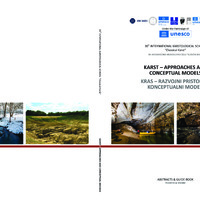To what extent reactivated faults are (not) responsible for karst process: example from Serbian Carpatho-Balkanides?
Објеката
- Тип
- Саопштење са скупа штампано у изводу
- Верзија рада
- објављена
- Језик
- енглески
- Креатор
- Ana Mladenović, Jelena Ćalić
- Извор
- Abstracts and Guide Book 30th International Karstological School "Classical Karst" Karst - Approaches and Conceptual Models
- Уредник
- Astrid Švara, Nadja Zupan Hajna, Franci Gabrovšek
- Издавач
- Ljubljana : Scientific Research Centre of the Slovenian Academy of Sciences and Arts (ZRC SAZU), Karst Research Institute
- Датум издавања
- 2023
- Сажетак
- Carpatho-Balkanides represent part of the complex Dinaric – Carpatho – Balkan orogenic system, that geomorphologically dominates the central part of the Balkan Peninsula. The existence of this orogenic system is a result of closure of the Neotethys ocean and subsequent convergence of the Adriatic microplate and the Eurasian continent, that has been still active in the recent times. Such geodynamic characteristics conditioned complex tectonic structures, multiply reactivated during Late Cretaceous and Cenozoic times. The main aim of this work is to determine impact of these reactivated faults on the formation and evolution of karst process in the area of the East Serbian Carpatho-Balkanides. This was done by studying relationship of the evolution of karst caves or their specific conduits and mapped tectonic structures. For that purpose, three key areas have been chosen. The northernmost area, Dževrinska greda, is situated in the part of the orogen dominated by dextral strike-slip tectonics, related to the activity of the Poreč – Cerna-Jiu Fault during Oligocene to recent times. The central part of the investigated area, around the Mala Bizdanja Cave, is situated in the area in which tectonic regime is defined as transpressional, with regionally important structures multiply activated during Late Cretaceous and Miocene – recent times. The southeasternmost area is located in the Vidlič thrust zone, where compressional events were active during Cretaceous and Miocene times. Preliminary results from several karst caves show that proto-conduits are mainly formed along regionally important fault structures, occasionally assisted with mechanical erosion in areas of fault-related rocks.
- почетак странице
- 135
- isbn
- 978-961-05-0747-5
- Subject
- Carpatho-Balkanides, karst caves, reactivated faults, transpressional tectonics
- COBISS број
- 153750275
- Шира категорија рада
- М60
- Ужа категорија рада
- М64
- Права
- Отворени приступ
- Лиценца
- All rights reserved
- Формат
Ana Mladenović, Jelena Ćalić. "To what extent reactivated faults are (not) responsible for karst process: example from Serbian Carpatho-Balkanides?" in Abstracts and Guide Book 30th International Karstological School "Classical Karst" Karst - Approaches and Conceptual Models, Ljubljana : Scientific Research Centre of the Slovenian Academy of Sciences and Arts (ZRC SAZU), Karst Research Institute (2023) М64
This item was submitted on 25. децембар 2023. by [anonymous user] using the form “Рад у зборнику радова” on the site “Радови”: http://drug.rgf.bg.ac.rs/s/repo
Click here to view the collected data.
